Huh?
‘Oh, I’m sorry, I thought you said you had been making cheeeeeese. Er. Haha.’
That was the gist of a conversation I had with a new friend a couple of weeks ago. And I HAD said I had been making cheese. She hadn’t missheard me. And now your turn-‘Say what, Hen? Cheese? What do you mean?’
I mean cheese. Mozzarella, to be specific. Why? Because I like to know how to do things myself, even better if the project is a little fiddly and involved. And because I like cheese, dammit!
Now, this is not something that you can just make at home without a few specific ingredients that you need to organise first.
And while the cheese ingredients that I bought did come with some recipes and how-to tips, I’ve also been doing some extra reading about the art of cheesemaking. If you are interested too, I recommend that you check out these books. And if making your own cheese is not something you’d be up for, you might still find it interesting to know how the cheese you like to eat is made, so read on. And if not-well, apart from a few hopefully witty asides, you may not be into this post and might want to have a look at one from another day. Or not. Up to you really.
I won’t give you the recipe exactly because it is a bit wordy and as I mentioned, you are unlikely to have the ingredients just lying around. And if you DO decide to make some for yourself, my advice would be to read one of the books I have linked to above. And maybe get your own cheese making kit from a place like Green Living Australia (who, incidentally, I am not affiliated with, even though I keep mentioning them-they just seem like the best place to get these kinds of ingredients in Australia. You could also try somewhere like Cheeselinks.)
Ok, cheesy friends who have chosen to read on-have a gander at what you need to get started:
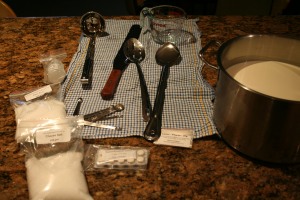
Special and not-so-special cheesy ingredients:
4 litres of full cream milk in a big pot with a thick base. You can use buffalo or sheep milk if you can get it, otherwise cow’s milk is fine;
calcium chloride-this is an ingredient needed to counter the effects of homogenisation on the supermarket milk you are probably using. If you don’t add the calcium chloride you will not get proper curd formation in your milk;
citric acid-commonly found in citrus juices-isn’t as ‘chemically’ as it sounds and increases the acidity of the milk;
lipase-an enzyme, and an optional add-in, especially recommended if you have used supermarket-type pasteurised and homogenised milk. It enhances the flavour of the cheese;
vegetarian rennet-coagulates the milk, causing it to separate it into curds and whey;
cheese salt-normal table salt has a different crystal shape apparently, and that makes it unsuitable for cheesemaking. Also, cheese salt is not iodised. The salt is used not only for flavour but is also an important element in preserving the cheese. (I actually found my cheese to be a little bit salty for my taste as I prefer creamy, less salty mozzarella-I will reduce it slightly next time.)
So, the process: (from Green Living Australia’s 30 minute mozzarella booklet and my hard-won experience)
Firstly you add the calcium chloride, lipase and citric acid, all dissolved individually in some unchlorinated water and stirred in separately to the milk. So far it still just looks like a pot of milk.
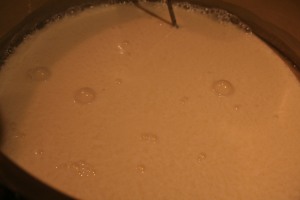
Milk starting to curdle as it warms up...
Then you slowly heat the milk to 32 degrees C, which doesn’t seem like much-but with the heat the milk starts to curdle. Once you reach the right temperature you add the rennet (also dissolved in water like the other ingredients) and heat it further, up to 38-40 degrees C. Regulating the temperature is a bit hard, I found I needed to turn the gas flame off before I got to the right temperature so it didn’t shoot up beyond 40 degrees. Maybe I need one of those tricky heat dispersing mats? By now the milk has started to separate into curds (the solid parts) and whey. Exciting!
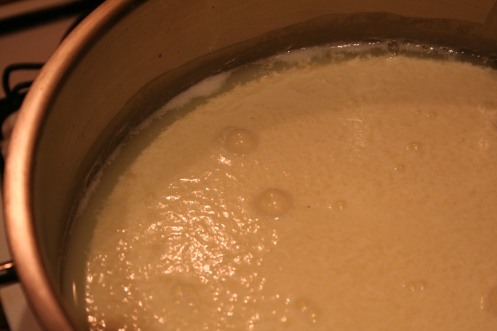
Hey-curds and whey! (You can see the line between the curd-solid-and the whey-the liquid-at the edge) Pull up a tuffet and keep your eyes peeled for spiders...
After about 5 minutes at this temperature the curds should have formed a fairly solid mass with a clean ‘break’ when you slide a knife into the centre and angle the blade slightly. I never really got this clean break and had to leave the milk at this temperature-which eventually climbed higher-for quite a lot longer, at which point I admit I started feeling a bit nervous that I was going to have 4 litres of soured, slightly coagulated milk to deal with. Oh dear.
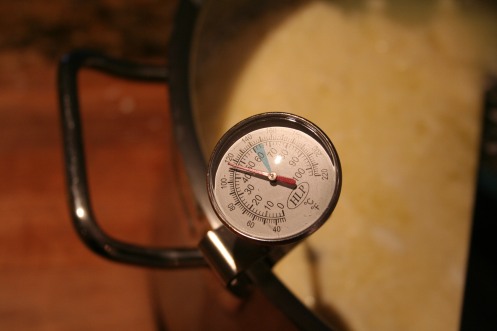
Ok-so my temperature has definitely crept above the magical 38-40 degrees C...
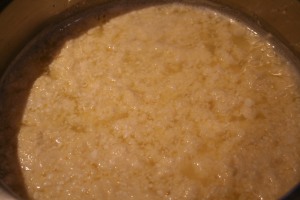
...but where is my beautifully formed, solid lump of curds? This can't be right-can it?
After this, you use a long knife to cut the curd into cubes while it is in the pot, then you cook the curds-put the pot back on the heat and stir the curd at 40 degrees for 5 minutes.
And now for the exciting bit. Or the tense bit, depending on how well your curds formed…You can either knead the curds (yes, knead-like bread!) in a hot bath of the whey,which has been heated to 85 degrees C. Thick rubber gloves a must. This is the traditional way that mozzarella is made. But there is another way which involves using the microwave, and that is the method I chose-I didn’t fancy splashing around up to my elbows in hot whey. And good thinking it was, Red Hen, since Little D ended up waking from a snooze right in the middle of this step. That made things a bit awkward and I was glad I didn’t have a big ol’ pot of whey bubbling away on the stove.
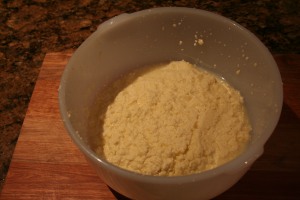
The bowl of curds, supposedly ready for kneading. Hmm.
So, you scoop your curds into a microwave safe bowl. Well-problem number one-my curds hadn’t formed too well and were kind of small and cottage cheese-like-so I actually sieved the curds out of the whey to make sure none went south through the big holes of a colander or slotted spoon! You need to press as much whey as possible out of the curd before you can start the next step which is…
Kneading!! You microwave the curds on high for 1 minute, pour off any extra whey and then fold the curds over themselves until you have formed one piece. Hmm. This really wasn’t happening for my curds at this stage. Oh well, next step…
Same as above but only microwave for 30 seconds before kneading. Ummm-mine is still in little separate curds like cottage cheese. You can’t knead cottage cheese! Help!
Well, the next step is the same-30 seconds of microwaving and kneading, by which stage the curds are supposed to have formed one smooth, lovely, shiny ball when you have kneaded them for a little while. What? But mine is…oh no. Has this been a massive failure and waste of time and milk? You KNOW how I hate wasting milk. And by now Little D was awake and needing attention,’ Mum, I need attention! Play with me! Look at me! Sing a song and do a little dance and now hold me and don’t put me down and stop that project you are doing right now and hang out with meeeee, Mumeeeee, waaaah!’
Ahem. A great environment for concentration as you can tell.
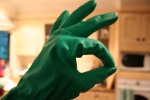
S'ok, Lil' Red. Just keep kneading those curds...
Anyway, by now I was faced with a curdy dilemma. What to do? Well, I guessed I would just have to keep microwaving and kneading-or sloshing around with my gloved hand as the case may be-this pile of curds in the hope that they might eventually come together into a kneadable mass. So I did. And still nothing. And after yet more more microwaving….still nada.
After 5 more rounds with the microwave I was about to give up. It was obviously not going to work. Maybe I should have used more rennet? More citric acid? So disappointing.
Oh well-one more time in the microwave and then that’s it. No more.
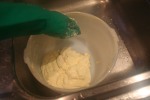
Hang on.....those curds are coming together!
.
And that heart sinking decision to chuck it in seemed to be the magic bullet for my mozzarella-it finally, FINALLY came together and started to get smooth…and shiny…and kind of stretchy…and mozzarella-ey! It felt a lot like kneading a big lump of bubble-gum, which was kind of cool. It got harder and harder to work as it got cold, so I quickly broke it into smaller golf-ball-sized pieces and shaped them into the smoothest looking balls I could and there they were. Mozzarella. Made by me. Woot! How cool.
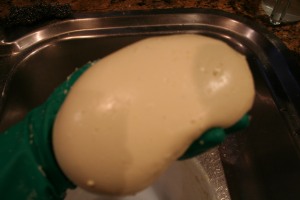
And that's mozzarella. Sorry for the steamed up camera lens. It was the hot whey. I swear.
And you know what-they tasted pretty good.
So where did they end up?
On homemade margherita pizzas of course!
Cheesemaking WIN.
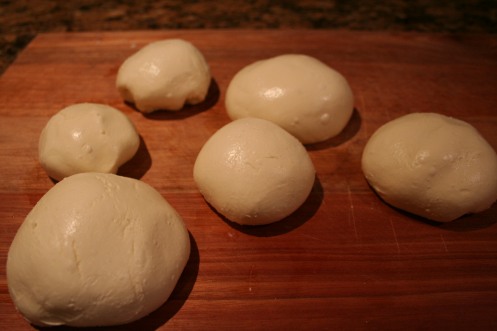

omigod, omigod, omigod, that is so fucking cool. I wanna come over and do a cheesemaking class at your house!!!!!!
Yep, let’s do it. Although you can see my good result was slightly accidental…but I will get better, I hope. Gonna post an easy home ricotta recipe this weekend, I hope-much simpler than mozzarella or yoghurt, and no special ingredients necessary!
Blessed are the cheesemakers…
;P
Holy! That looks SO GOOD!! You are a kitchen genius, we just go in there slap some ingredients together and call it dinner. Your patience is extreme and look how amazing it turned out! Impressed! XO
Hi Eatpress!! And thanks for your cheese praise. I probably SHOULD focus a bit more on the dinner at the moment. But I do like a project. I do…
[…] This post was mentioned on Twitter by Tammi Jonas, K.L. K.L said: @tammois here's my long winded post from a while ago. Incl links for supplies: http://bit.ly/gbS53V […]
Tweets that mention Huh? « Little Red Hen -- Topsy.com said this on February 3, 2011 at 11:44 am |
[…] even our favourite Greek style, but I like it that way. I’m now so inspired I plan to try mozzarella – @littleredhen has inspired me and I’ve been watching @beeso’s cheesemaking over on the Twitterz with envy for a year […]
Making Yoghurt: A Gateway Process to Cheese-making » Tammi Tasting Terroir said this on February 4, 2011 at 2:37 am |